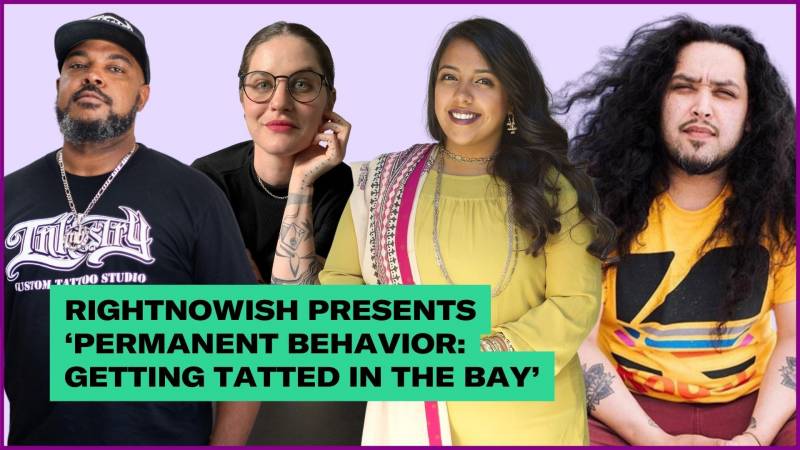Hey Rightnowish listeners, you can help shape the future of the podcast! Just fill out a short survey.
On Rightnowish, we feature a lot of stories about art that’s here today, gone tomorrow—and we wanted to focus on art that lasts forever. So, we turned to tattoos.
‘Permanent Behavior: Getting Tatted in the Bay,’ our four-part series, kicks off this week. In these stories, we dive into the permanence of ink as it resides on impermanent beings.
We hear from the creators of the tattoos—the artists behind the needles—all of whom come from a unique mixture of crews, cultures and countries of origin. The artwork, as well as the stories behind the art, are proud byproducts of the Bay.
In anticipation of the rollout, the Rightnowish producer and I decided to chop it up about our affinity for the ink. We talk about what stories our own tattoos memorialize and what we hope y’all get out of this series.
Below are short descriptions of each artist we are highlighting this series.
Miguel “Bounce” Perez is showing the culture of his community through his designs. He grew up in West Berkeley, and recalls seeing cholo-style lettering done by his uncle, and the illustrations his mom created while sitting at the kitchen table. His father was a member of a local car club, and folks in his community were employed by the local factories. But when the factories went, so did the soul of the neighborhood.
Through graffiti murals and tattooing, Perez tells the story of his neighborhood while amplifying communities around the world; he’s part of an art collective called Trust Your Struggle, which paints murals in countries for historically colonized and under-resourced communities.
Sophia Blum a.k.a. Pio Poke is a stick-and-poke (or hand poke) artist who specializes in detailed botanical and textile designs. But Sophia is more than just a tattoo artist. Raised in Berkeley, she is part owner of Thorns Tattoo. After some sour experiences working in shops where owners made the lion’s share of the income, she found a way to work with friends to create an artist-owned shop. Beyond artistic and financial liberation Sophia, along with the other artists at Thorns, use their craft to support social justice causes — hosting benefits and donating the proceeds to organizers on the front lines.
Sabreena Haque is a highly regarded henna artist who specializes in artwork for people celebrating life transitions—occasions such as, weddings, pregnancies, or breakups—as well as “menna,” or henna for men. From her time in Pakistan, learning under the tutelage of family, Haque gained her mastery of the rich and varied craft—which is popular in India, as well as countries throughout Africa, the Middle East region and Pakistan. Now, Haque is taking on a new endeavor: permanent tattoos through her work at Gold Leaf Ink in San Francisco.
Mo’ Better is the owner of Inkestry tattoo shop in the East Bay suburb of Livermore. He started off as an airbrush artist in the early ’90s, and is now one of the most sought-after tattoo artists in the Bay Area. He’s inked multiple generations of families as well as professional football players. Surprisingly, he has zero permanent ink on his body—and has no plans to change that.
Mo’ Better’s success didn’t come without hurdles. When he first picked up the craft, people laughed at the idea of a Black man getting into the industry. He tried to apprentice in different shops, but was ignored. Mo’ Better cuts through the racial bias tampering the industry, and is an example of what happens when you take your work seriously and invest in yourself.
Listen to Mo’Better’s episode.
Our four featured artists come from different backgrounds, have different visions for their craft as well as their own visual styles—and while their work is only as permanent as the canvases they paint, their stories about ink are archived with us forever.

If you enjoyed this story, you can show your love for KQED’s podcasts by going to https://kqed.org/donate/podcasts
Rightnowish is an arts and culture podcast produced at KQED. Listen to it wherever you get your podcasts or click the play button at the top of this page and subscribe to the show on NPR One, Spotify, Apple Podcasts, TuneIn, Stitcher or wherever you get your podcasts.


